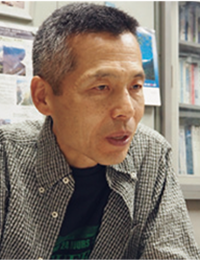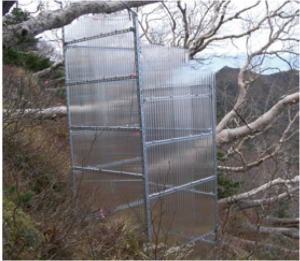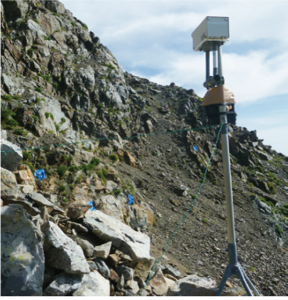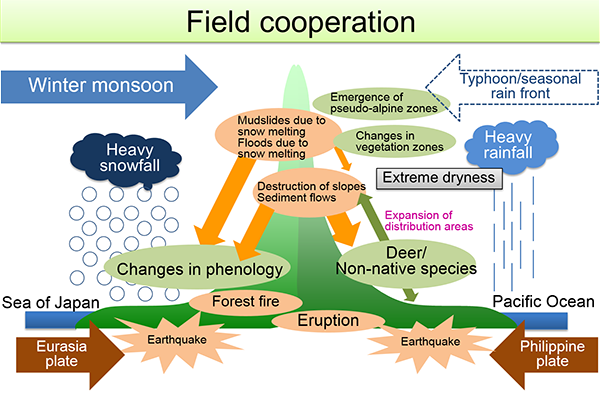他のメンバー : 山中 勤 出川 洋介 沼田 治 上野 健一 植田 宏昭 浅沼 順 池田 敦 田島 淳史 奈佐原(西田) 顕郎 門脇 正史 鈴木 亮 廣田 充
キーワード: 中部山岳地域、気候変動、地球温暖化、生物多様性、生態系
http://jalps.suiri.tsukuba.ac.jp/
 中部山岳地域はその地形や環境の特性により、気候変動や人間活動の影響が早いレスポンスで顕在化するという特徴があり、地球温暖化等の環境変動を知る上で貴重な研究フィールドと言えます。リサーチユニットの5年間では、気候の変化による山岳地域の生態系への影響や、水や土砂の動きといった自然の条件の変化を調べると共に、人間の暮らしにどのような影響があるのかを、筑波大学・信州大学・岐阜大学の3大学の研究チームが中部山岳地域をフィールドに連携し、主に生物系、農林系、地球科学系分野での様々な学際的研究を行いました。
中部山岳地域はその地形や環境の特性により、気候変動や人間活動の影響が早いレスポンスで顕在化するという特徴があり、地球温暖化等の環境変動を知る上で貴重な研究フィールドと言えます。リサーチユニットの5年間では、気候の変化による山岳地域の生態系への影響や、水や土砂の動きといった自然の条件の変化を調べると共に、人間の暮らしにどのような影響があるのかを、筑波大学・信州大学・岐阜大学の3大学の研究チームが中部山岳地域をフィールドに連携し、主に生物系、農林系、地球科学系分野での様々な学際的研究を行いました。
リサーチユニット終了後の2015年度からはさらに静岡大学・富山大学・山梨大学が連携機関に加わり、フィールドも日本海側から太平洋側まで中部山岳地域を縦断する範囲へと広げ、気候変動が山岳地域あるいは都市域へどのような影響を与えるのかを総合的に紐解く活動を続けています。

フィールドの特徴を利用し、気候変動の影響を様々な視点で検証する

図1:温暖化実験(周囲より高温にして植物への影響を調べる)
フィールドでは、例えば山の中に温室を設置し、温暖化の条件を人工的に作り出します。温室の中で植物がどう変化するかを観察したり、人為的に植物を伐採し植生の変化を起こし、そこで土砂の移動の実験をしました。各大学が持つフィールドの特徴に合わせて様々な実験を行ったり、同時に実験を行い比較する事で気候変動の影響を検証しました。
中部地域全体を縦断するフィールドへと研究チームとテーマを拡大
国際連携も活発化

図2:インターバルカメラで崩壊発生をとらえる
中部山岳の縦断地域は活発な地殻変動で山は隆起し、地形は早いスピードで変化しています。また、この地域の気象は、日本海側は豪雪地域、太平洋側は豪雨地域で、山岳地域から溢れた水で崩壊・洪水等が起こり下流へ影響を与えています。世界的にみてもこれだけダイナミックな変化が起きているフィールドは少なく、中部山岳地域は謂わば地球全体を理解するための1つのモデルと言えます。この広いフィールドで、大学間が連携して同時に気象や生態系の調査を行うことにより中部山岳全体で起きている変化を理解することが出来ます。
また、気候変動が観光や産業へ与える影響について、環境経済学や集落の移り変わりといった社会科学分野にまで研究テーマを広げました。今では「日本山岳アカデミア」と命名した140名程度の大きな組織となり、組織を跨いで若い研究者の教育や国際的な共同研究を繰り広げています。将来的には、この組織が山岳科学における一つの学会組織となることを目指しています。
社会への貢献・実績
● 地学雑誌「中部山岳地域の自然環境変動」特集号(122 巻4 号)を出版
● 国際シンポジウム「山岳科学と気候変動に関する生態学的展望」を開催(平成25年11月・菅平高原)
● アジア・オセアニア地球科学会国際シンポジウム「Mountain Response to Climate Change」を開催
(平成26年7月・札幌)
● 国際シンポジウム「急傾斜山地における斜面変動と生態系」を開催(平成26 年10 月・井川演習林)
取材:平成27年8月28日
Research to analyze a variety of environmental changes in the field of the Japanese Alps region
Unit members : Yamanaka, Tsutomu Degawa, Yosuke Numata, Osamu Ueno, Kenichi Ueda, Hiroaki Asanuma, Jun Ikeda, Atsushi Tajima, Atsushi Nasahara (Nishida), Kenlo Kadowaki, Seishi 鈴木 亮 Hirota Mitsuru
Unit name: Environmental Change in Japanese Alps
Keywords: Japanese Alps, climate changes, global warming, biodiversity, ecosystems
 The Japanese Alps region is a valuable research field to examine global warming and other environmental changes because climate changes and the influences of human activities in this area become noticeable in a shorter period of time than in other areas due to its topographic and environmental characteristics. The research unit conducted a five-year study of the influences of climate changes on ecosystems in mountainous areas as well as changes in the movements of water and soil and other natural conditions. Furthermore, a research team consisting of researchers of the University of Tsukuba, Shinshu University, and Gifu University with an interest in Japanese Alps region as an academic field, collaborated to conduct multidisciplinary research in the fields of organisms, agriculture/forestry, and geoscience to examine the effects of climate changes on the lives of people.
The Japanese Alps region is a valuable research field to examine global warming and other environmental changes because climate changes and the influences of human activities in this area become noticeable in a shorter period of time than in other areas due to its topographic and environmental characteristics. The research unit conducted a five-year study of the influences of climate changes on ecosystems in mountainous areas as well as changes in the movements of water and soil and other natural conditions. Furthermore, a research team consisting of researchers of the University of Tsukuba, Shinshu University, and Gifu University with an interest in Japanese Alps region as an academic field, collaborated to conduct multidisciplinary research in the fields of organisms, agriculture/forestry, and geoscience to examine the effects of climate changes on the lives of people.
Following the completion of the research unit, Shizuoka University, the University of Toyama, and University of Yamanashi participated in the research activity in 2015, and the research subject has covered a wider area: the Japanese Alps region that covers both the Japan Sea and Pacific Ocean sides. Comprehensive research has been conducted to examine the influences of climate changes on both mountainous and urban areas.

Mountainous fields on the Japan Sea side, in the inland area, and on the Pacific Ocean side in which the types of long-term and sporadic environmental changes and ecological responses significantly vary.
Examinations of the influences of climate changes from various perspectives, utilizing the characteristics of different fields

Figure 1: An experiment on global warming (The temperature in the greenhouse is raised, and the effects on plants are examined.)
In field experiments, greenhouses are placed in mountains to artificially create conditions required to cause global warming. We observed changes in vegetation in greenhouses, and conducted experiments to artificially cause vegetative changes by cutting down plants and examine the movement of soil. Each university conducts a variety of experiments according to the characteristics of their fields, or two or more universities conducted experiments at the same time to examine the influences of climate changes.
Expansion of the research team and theme – a wider research field that covers the overall central mountainous area, and the promotion of international collaboration

Figure 2: Visual recording of slope failure with a time-lapse camera
Mountains uplifted by active crustal movements are located in the Japanese Alps region – where mountain ranges run longitudinally, and landforms changes at a high rate. From the viewpoint of meteorology, the Japan Sea and Pacific Ocean sides of the area have heavy snowfall and rainfall, respectively. Slope failures and floods triggered by excessive water possibly cause significant damages to downstream areas. In few fields of the world other than the Japanese Alps region, are such dynamic changes caused. In this sense, the area serves as a model to understand the earth comprehensively. In this broad field, universities collaborate with each other and conduct surveys on meteorological phenomena and ecosystems to comprehend changes that occur in the Japanese Alps region as a whole.
The research subjects also cover the field of social science, including environmental economics and changes in colonies, to examine the influences of climate changes on tourism and industries. The research team has developed into a large organization referred to as the “Japanese Alps Inter-University Cooperative Project” consisting of approximately 140 researchers from many different organizations, and implemented education for young researchers and conducted international collaborative research. The organization aims to become an academic society in mountain science in the future.
Social contributions and achievements
- Publication of a special issue (Vol. 122, No. 4) of “Changing Natural Environments in the Japanese Alps Region”, Journal of Geography
- “Ecological perspective in mountain sciences and climate change”, an international symposium (November 2013, Sugadaira Plateau)
- “Mountain Response to Climate Change”, an international symposium of the Asia Oceania Geosciences Society (July 2014, Sapporo)
- “Slope dynamics and ecosystem in steep mountains”, an international symposium (October 2014, Ikawa Research Forest)
Interviewed on August 28, 2015
